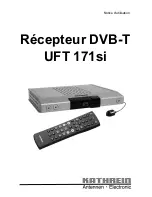
4
SENSITIVITY ADJUSTMENT
Located on the bottom side of the IR receiver, the sensitivity adjustment
allows fine adjustment of the reception range and performance in various
environments. For example, if there is too much light interference affecting the
performance of the IR receiver, the sensitivity can be decreased. Also, if the
talk-back LED is constantly lit, sensitivity needs to be decreased until proper
remote operation is achieved.
Rotate Clockwise – Increase Sensitivity
Rotate Counter-Clockwise – Decrease Sensitivity
5
TROUBLE SHOOTING:
1. Perhaps the most common problem you may encounter is stray IR
(infrared) or RF (radio frequency) interference preventing proper
operation of the controlled equipment.
•
Fluorescent, Compact Fluorescent, Neon or Halogen lights,
Neon Art, and light dimmers.
•
Direct or reflected sunlight.
•
Infrared security sensors (active types).
•
RF radiation from TV sets that may be close to the Dinky Link
IR Receiver.
2. You can confirm the source of the interference by temporarily turning
off TV sets, isolating the Dinky Link IR Receiver from all sunlight and
turning off all lights, light dimmers and Infrared security systems.
Then check to see if the Dinky Link IR Receiver operates the
component.
•
Sometimes interference will cause the red Talk-Back LED on
the front of the Dinky Link IR Receiver to blink dimly,
intermittently, or continuously.
•
The Talk-Back Led should only blink when you are sending
infrared commands to the Dinky Link IR receiver from a
remote control.
•
It may be necessary to move either the interfering source of
the Dinky Link IR Receiver to achieve proper operation.
3. If the Talk-Back LED or the 283D Emitters do not blink when you are
sending IR commands to the Dinky Link IR Receiver from a remote
control, check the following:
•
Make sure the power supply is plugged securely into a live
AC electrical outlet.
•
Be sure the stereo mini plug of the Dinky Link IR Receiver is
plugged into the “IR RCVR” jack on the CB12 Connecting
Block, not into the “OUT” jack.
•
Check to see that all the mini plugs are properly seated into
the mini jacks on the CB12 Connecting Block.
4. If the 283D Emitters blink, but the component does not respond,
reposition the 283D Emitter(s). They may not be located directly over
the component’s infrared receiving “window”. Consul the owner’s
manual of the unit or the manufacturer for the exact location of the
infrared “window”.






















